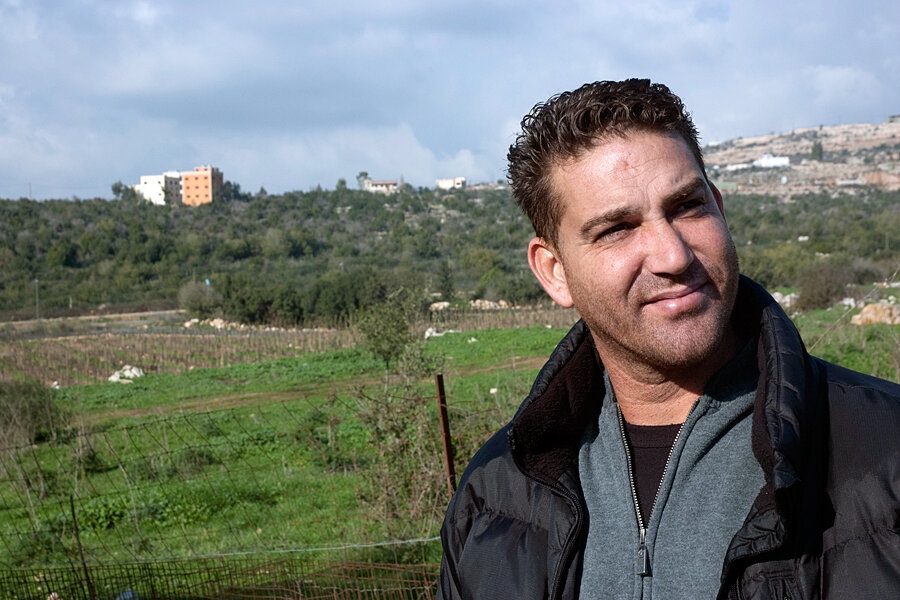Is Hezbollah tunneling into Israel? Army looks into village's old complaint.
| Moshav Zarit, Israel
For months, residents of this northern border village complained that they were hearing drilling noises underground, but that seemed to elicit little response from the Israeli army. Until now.
With tensions rising along the Lebanese border over the past week and a half, the army began digging Wednesday for suspected Hezbollah tunnels – even before the Lebanese militant group killed two soldiers in a cross-border attack late that morning.
Kobi Cohen, deputy head of security for Zarit, says the community has been hearing unusual sounds for a few years.
“It started with small noises, like a hammer and anvil,” Mr. Cohen told a group of visiting journalists last month. “The noise [became] so intense that people’s furniture and objects in their homes actually moved.”
Cross-border tunnels proved to be one of the most frightening weapons in Israel’s summer war with Hamas, which adopted the technique from Hezbollah and launched several attacks into Israel via concrete-fortified channels under Gaza’s sandy soil.
Such tunnels, though much harder to build in the rocky hills along Israel’s northern border, could enable Hezbollah to launch a far more devastating attack than Wednesday’s hit on the patrol that killed two Israeli soldiers and wounded seven.
Like many of the small communal villages dotting Israel’s northern border, Zarit, home to about 70 families, lies a stone’s throw from the border security road the Israeli military regularly patrols. Some families live as close as 200 yards from the border, and can see Lebanese residents going about their day just over the fence.
2006 border incident
In 2006, Hezbollah fighters crossed the border fence between Zarit and Moshav Shtula, another communal village just a mile to the east, and killed three Israeli soldiers while kidnapping two more, setting off a month of fighting that left at least 160 Israelis and 1,190 Lebanese dead. A tunneling incident now could potentially spark a fresh conflict, though both sides seem wary of such an escalation.
The Israeli Defense Forces (IDF) has long known of the tunneling capabilities of Hezbollah, which prior to 2006 built an extensive system of underground bunkers and rocket-launch sites. Many of those facilities were taken out by Israeli strikes during the war; Hezbollah has said it is preparing for a far greater conflict.
Since the 2006 war, Lebanon’s southern border region has ostensibly been controlled by the United Nations authority, UNIFIL, whose white patrols could be seen rumbling along the ridge about a quarter of a mile from Zarit. But an Israeli security analyst says Hezbollah merely took down its flags from outposts along the border and is continuing to operate, albeit with a lower profile.
And it has proved in the past to be able to evade the eye of the UN.
Among the underground Hezbollah facilities found during the 2006 fighting was one with air conditioning, a cafeteria, dorms, medical facilities, and 3-foot-thick cement ceilings – all built secretly in view of a United Nations outpost along Israel’s border.
Nothing found so far
The IDF, which drew criticism last summer for not preemptively thwarting the Hamas tunnel threat in Gaza, has been doing its own due diligence on its side of the Lebanese border.
“We haven’t to date found any tunnels or are aware of any specific tunnels that are leading into Israeli territory,” says Lt. Col. Peter Lerner, an Israel Defense Forces (IDF) spokesman. But given the heightened sensitivity along the border, they decided to start digging at Zarit as well to rule out the possibility. They were back again Thursday, continuing the work.
Residents say they’ve been hearing sounds for at least a few years, and initially contacted a seismologist to make sure the vibrations weren’t due to tremors in the earth. They also had scientists visit from Israel’s Technion university, but the results were either inconclusive or purposely kept quiet, says Ruth Adoni.
A long-time resident whose son, Yossi, is the head of Zarit’s local council, Ms. Adoni says the scientists stayed with a neighbor of hers who lives very close to the border and had complained of “some very, very loud drilling noises and vibrations.”
“She claimed some pictures fell off the wall,” Adoni says, adding that the noises in her neighbor’s house have since stopped. “So maybe they finished the tunnel now.”







